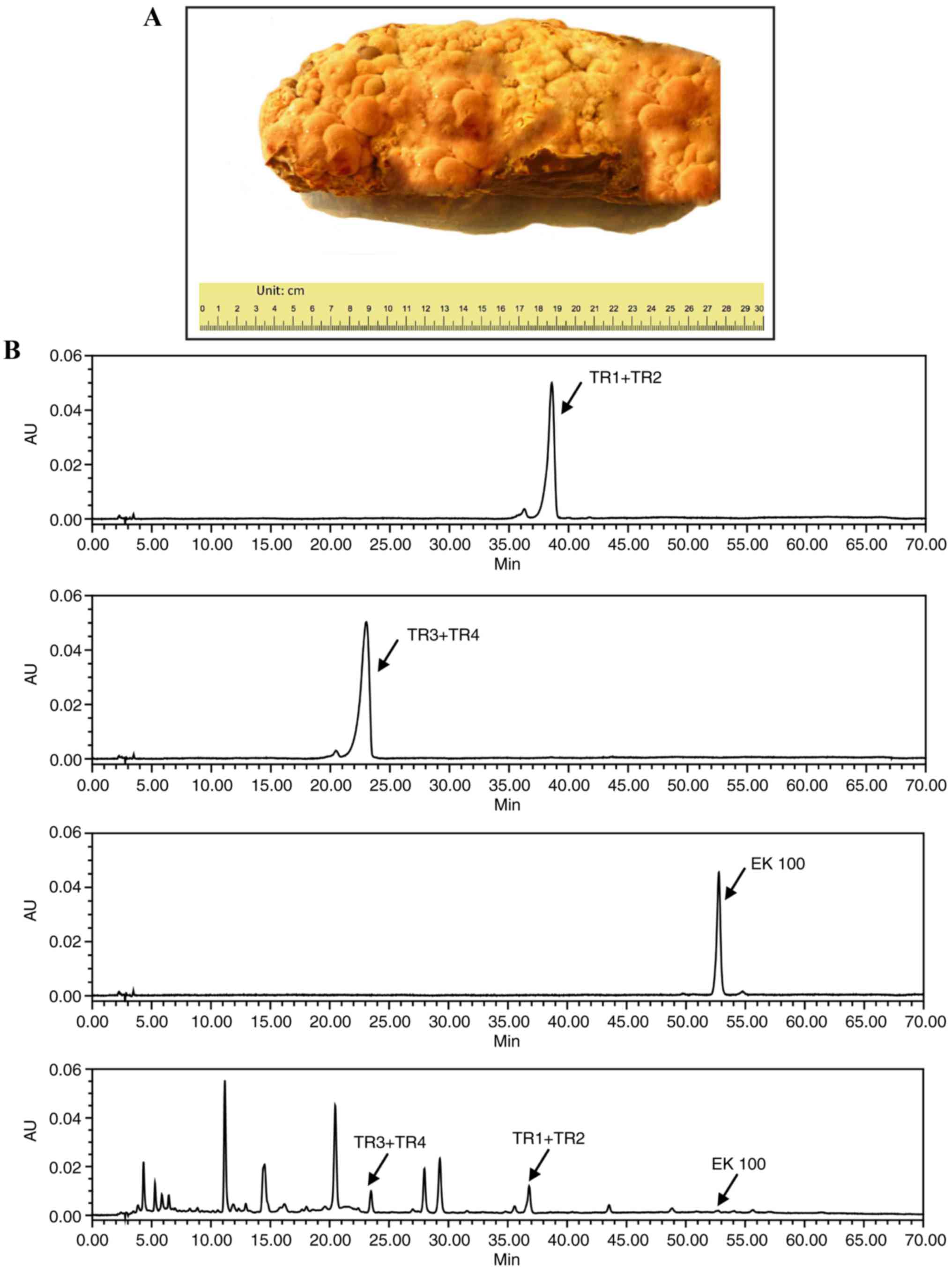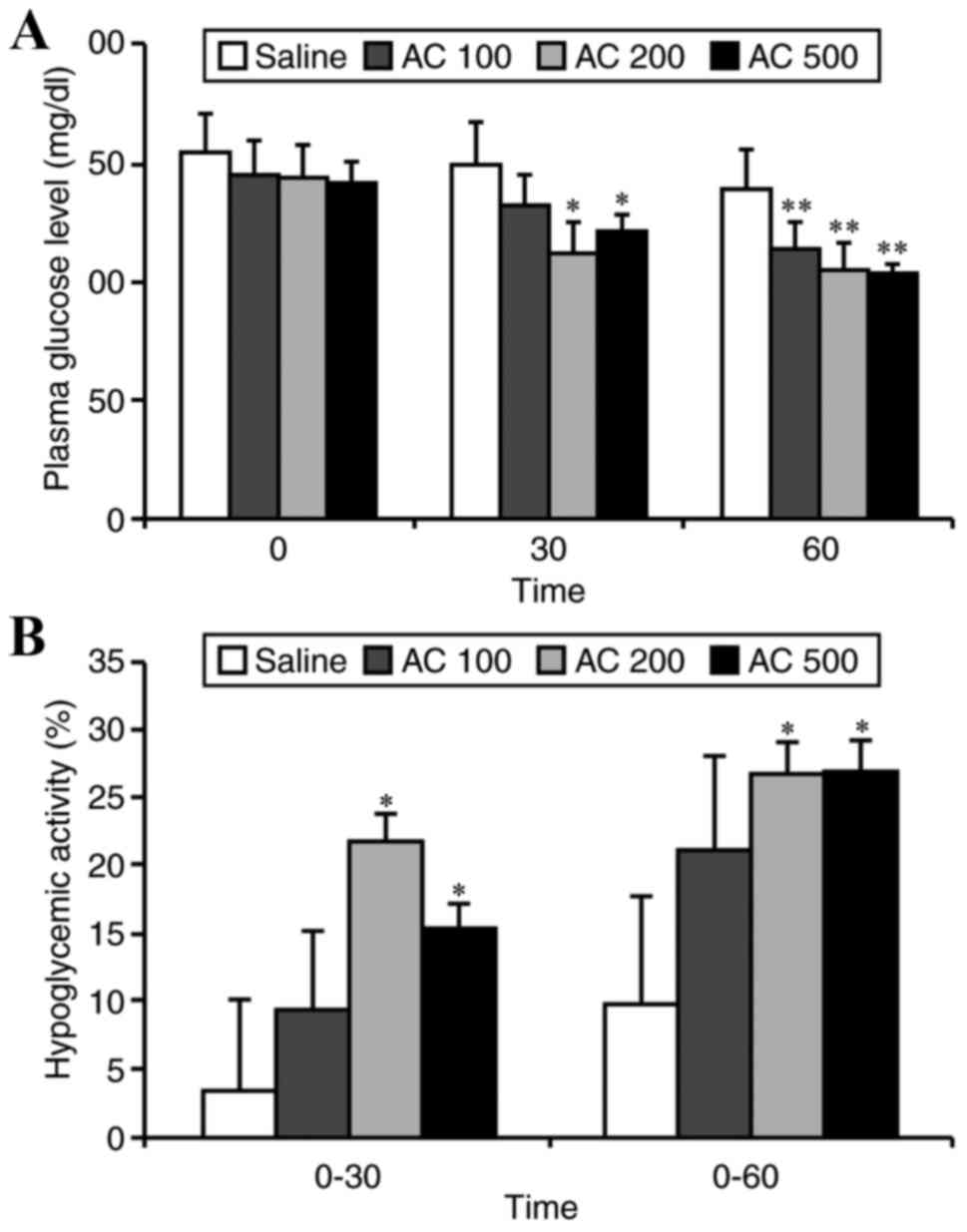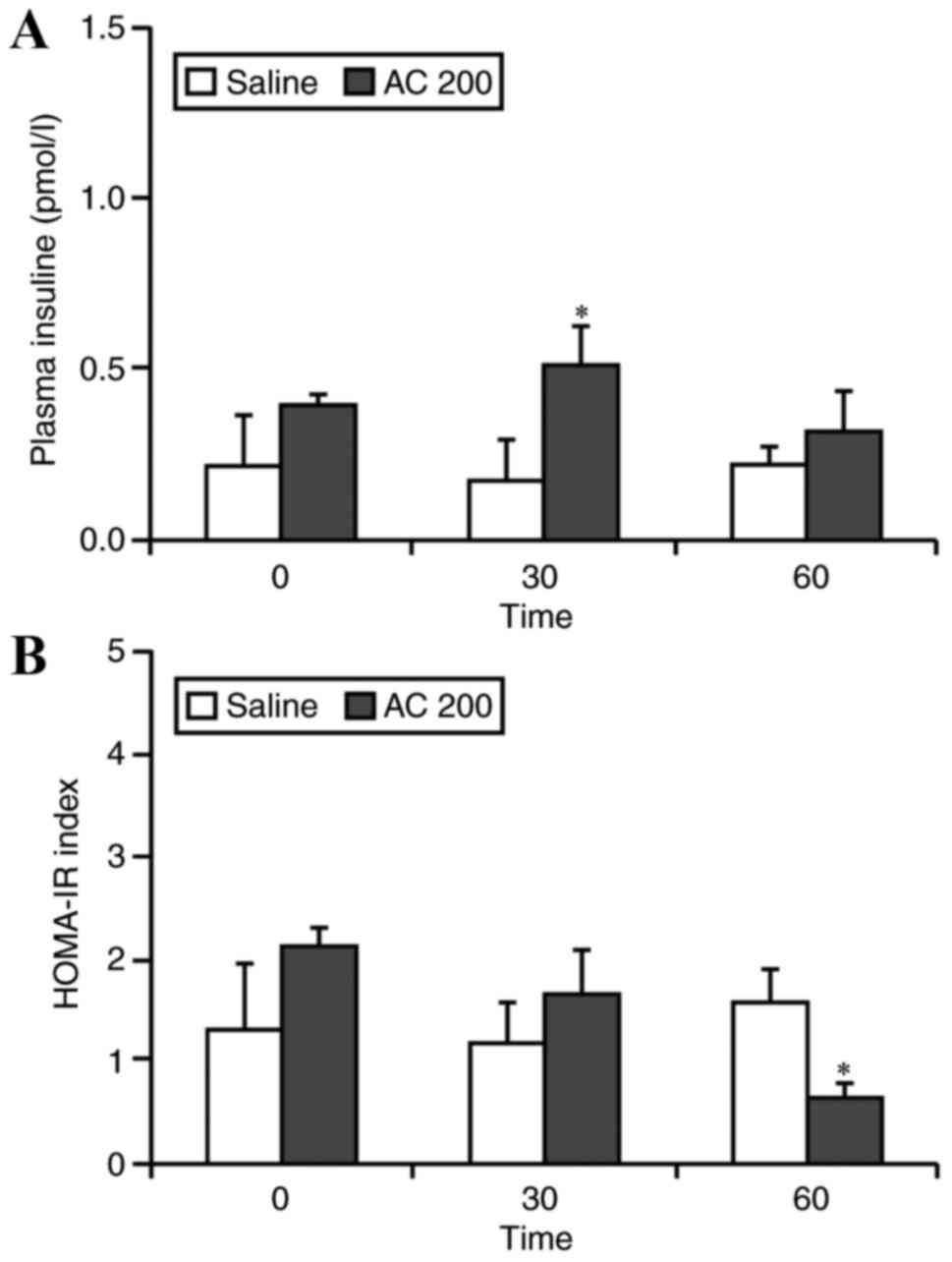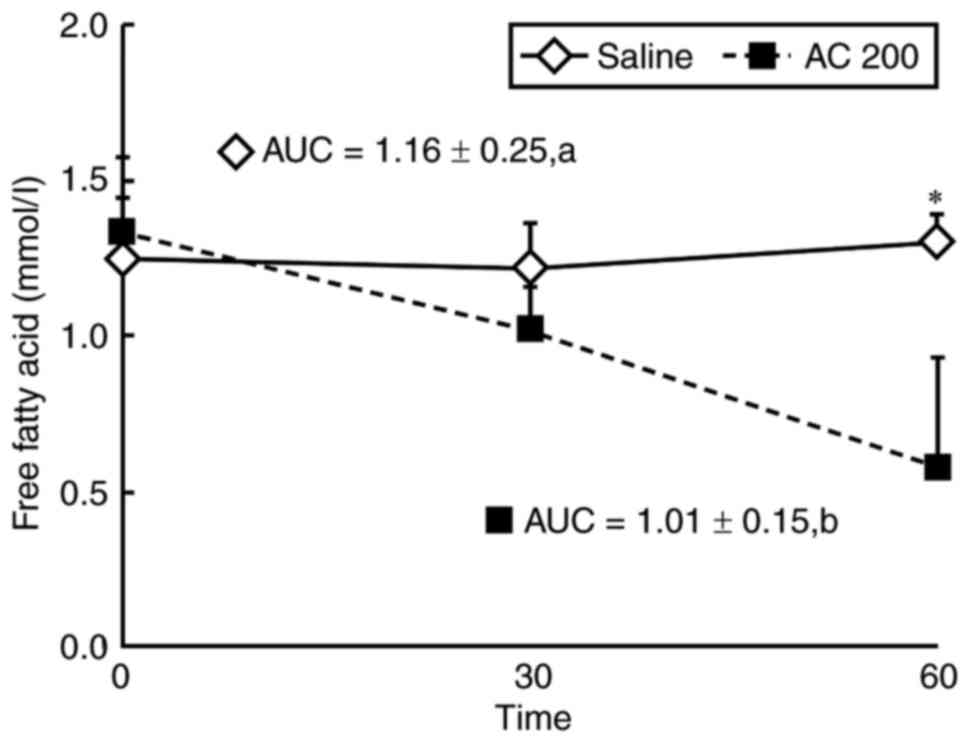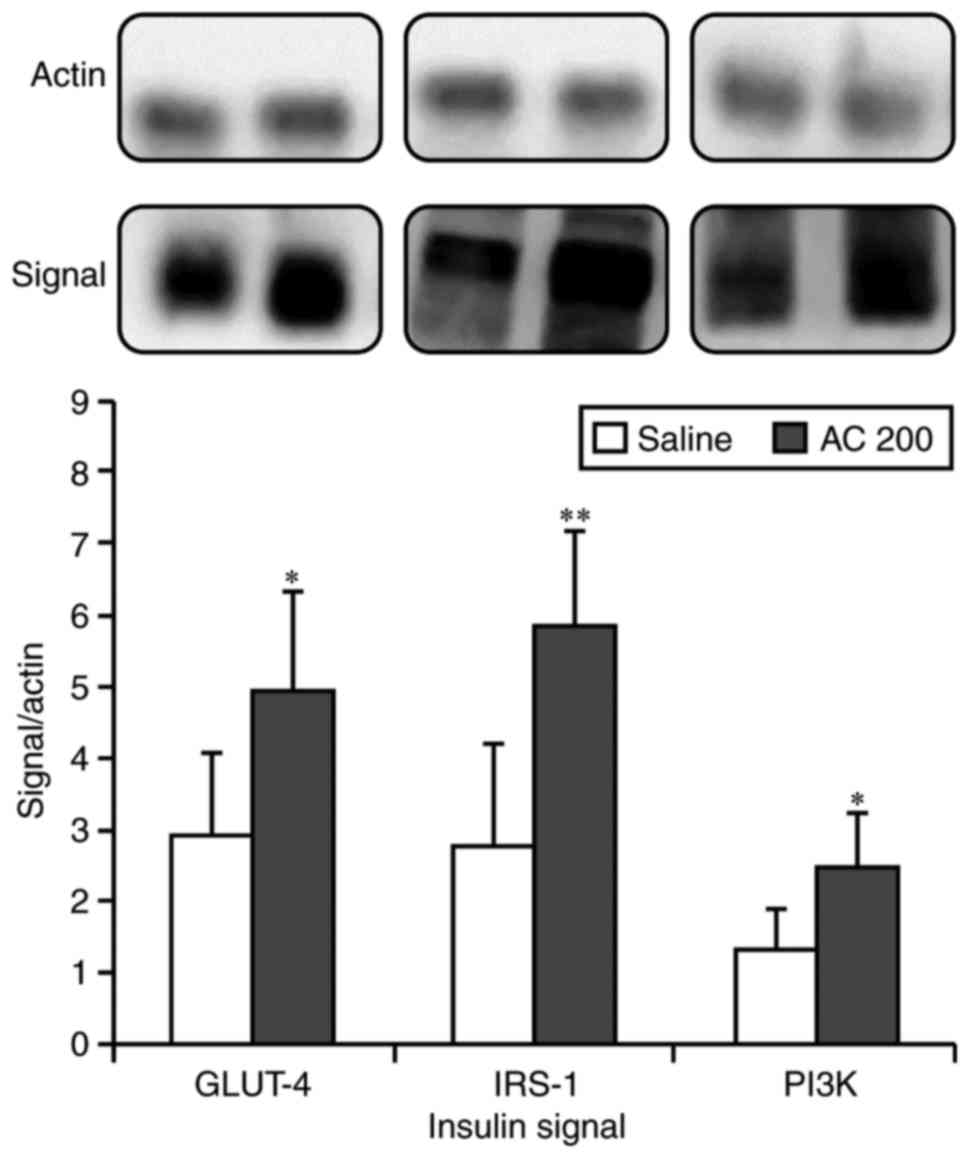|
1
|
Annadurai T, Vasanthakumar A, Geraldine P
and Thomas PA: Variations in erythrocyte antioxidant levels and
lipid peroxidation status and in serum lipid profile parameters in
relation to blood haemoglobin A1c values in individuals with type 2
diabetes mellitus. Diabetes Res Clin Pract. 105:58–69. 2014.
View Article : Google Scholar : PubMed/NCBI
|
|
2
|
Colussi G, Catena C, Lapenna R, Nadalini
E, Chiuch A and Sechi LA: Insulin resistance and hyperinsulinemia
are related to plasma aldosterone levels in hypertensive patients.
Diabetes Care. 30:2349–2354. 2007. View Article : Google Scholar : PubMed/NCBI
|
|
3
|
DeFronzo RA and Ferrannini E: Insulin
resistance. A multifaceted syndrome responsible for NIDDM, obesity,
hypertension, dyslipidemia, and atherosclerotic cardiovascular
disease. Diabetes Care. 14:173–194. 1991. View Article : Google Scholar : PubMed/NCBI
|
|
4
|
Lamounier-Zepter V, Ehrhart-Bornstein M
and Bornstein SR: Insulin resistance in hypertension and
cardiovascular disease. Best Pract Res Clin Endocrinol Metab.
20:355–367. 2006. View Article : Google Scholar : PubMed/NCBI
|
|
5
|
Hecksteden A, Grütters T and Meyer T:
Associations between acute and chronic effects of exercise on
indicators of metabolic health: A pilot training trial. PLoS One.
8:e811812013. View Article : Google Scholar : PubMed/NCBI
|
|
6
|
Eliasson B, Attvall S, Taskinen MR and
Smith U: Smoking cessation improves insulin sensitivity in healthy
middle-aged men. Eur J Clin Invest. 27:450–456. 1997. View Article : Google Scholar : PubMed/NCBI
|
|
7
|
Inzucchi SE, Maggs DG, Spollett GR, Page
SL, Rife FS, Walton V and Shulman GI: Efficacy and metabolic
effects of metformin and troglitazone in type II diabetes mellitus.
N Engl J Med. 338:867–872. 1998. View Article : Google Scholar : PubMed/NCBI
|
|
8
|
Jermendy G and Csermely P:
Thiazolidinediones-a new class of oral antidiabetic drugs. Orv
Hetil. 142:1547–1554. 2001.(In Hungarian). PubMed/NCBI
|
|
9
|
Chang SL, Lin JG, Chi TC, Liu IM and Cheng
JT: An insulin-dependent hypoglycaemia induced by
electroacupuncture at the Zhongwan (CV12) acupoint in diabetic
rats. Diabetologia. 42:250–255. 1999. View Article : Google Scholar : PubMed/NCBI
|
|
10
|
Chang SL, Lin KJ, Lin RT, Hung PH, Lin JG
and Cheng JT: Enhanced insulin sensitivity using electroacupuncture
on bilateral Zusanli acupoints (ST 36) in rats. Life Scie.
79:967–971. 2006. View Article : Google Scholar
|
|
11
|
Tzeng CY, Lee YC, Chung JJ, Tsai JC, Chen
YI, Hsu TH, Lin JG, Lee KR and Chang SL: 15 Hz electroacupuncture
at ST36 improves insulin sensitivity and reduces free fatty acid
levels in rats with chronic dexamethasone-induced insulin
resistance. Acupunct Med. 34:296–301. 2016. View Article : Google Scholar : PubMed/NCBI
|
|
12
|
Li SL, Huang ZN, Hsieh HH, Yu WC, Tzeng
WY, Lee GY, Chen YP, Chang CY and Chuu JJ: The augmented anti-tumor
effects of Antrodia camphorata co-fermented with Chinese medicinal
herb in human hepatoma cells. Am J Chin Med. 37:771–783. 2009.
View Article : Google Scholar : PubMed/NCBI
|
|
13
|
Song AR, Qin D, Zhao C, Sun XL, Huang F,
Kong C and Yang S: Immunomodulatory effect of polysaccharides
extracted from the medicinal mushroom Antrodia camphorata (higher
Basidiomycetes) in specific pathogen-free chickens. Int J Med
Mushrooms. 16:95–103. 2014. View Article : Google Scholar : PubMed/NCBI
|
|
14
|
Yue PY, Wong YY, Wong KY, Tsoi YK and
Leung KS: Current evidence for the hepatoprotective activities of
the medicinal mushroom Antrodia cinnamomea. Chin Med. 8:212013.
View Article : Google Scholar : PubMed/NCBI
|
|
15
|
Hsiao G, Shen MY, Lin KH, Lan MH, Wu LY,
Chou DS, Lin CH, Su CH and Sheu JR: Antioxidative and
hepatoprotective effects of Antrodia camphorata extract. J Agric
Food Chem. 51:3302–3308. 2003. View Article : Google Scholar : PubMed/NCBI
|
|
16
|
Yue PY, Wong YY, Chan TY, Law CK, Tsoi YK
and Leung KS: Review of biological and pharmacological activities
of the endemic Taiwanese bitter medicinal mushroom, Antrodia
camphorata (M. Zang et C. H. Su) Sh. H. Wu et al. (higher
Basidiomycetes). Int J Med Mushrooms. 14:241–256. 2012. View Article : Google Scholar : PubMed/NCBI
|
|
17
|
Lai MN, Ko HJ and Ng LT: Hypolipidemic
effects of antrodia cinnamomea extracts in high-fat diet-fed
hamsters. J Food Biochem. 36:233–239. 2012. View Article : Google Scholar
|
|
18
|
Kuo YH, Lin CH and Shih CC:
Ergostatrien-3β-ol from Antrodia camphorata inhibits diabetes and
hyperlipidemia in high-fat-diet treated mice via regulation of
hepatic related genes, glucose transporter 4, and AMP-activated
protein kinase phosphorylation. J Agric Food Chem. 63:2479–2489.
2015. View Article : Google Scholar : PubMed/NCBI
|
|
19
|
Weng CF, Chen CP, Shivaji SR and Hsu CY:
Compounds from antrodia camphorate and their use in treatment of
diabetes mellitus. US Patent 20150203430 A1. Filed January 22,
2014; issued July 23. 2015.
|
|
20
|
Kuo YH, Lin CH and Shih CC: Antidiabetic
and antihyperlipidemic properties of a triterpenoid compound,
dehydroeburicoic acid, from antrodia camphorata in vitro and in
streptozotocin-induced mice. J Agric Food Chem. 63:10140–10151.
2015. View Article : Google Scholar : PubMed/NCBI
|
|
21
|
Wen CL, Chang CC, Huang SS, Kuo CL, Hsu
SL, Deng JS and Huang GJ: Anti-inflammatory effects of methanol
extract of Antrodia cinnamomea mycelia both in vitro and in vivo. J
Ethnopharmacol. 137:575–584. 2011. View Article : Google Scholar : PubMed/NCBI
|
|
22
|
Kuo MT, Tseng WP, Tseng TL and Kuo YY:
Method for promoting insulin secretion by using compounds and
extracts isolated from antrodia camphorata US Patent 20160038549
A1. Filed August 7, 2015; issued February 11. 2016
|
|
23
|
Tsai PJ, Wang C, Chou CJ and Huang WC:
Method for controlling obesity using Antrodia camphorata US Patent
20150157673 A1. Filed December 5, 2013; issued June 11. 2015
|
|
24
|
Park TS: Composition for prevention or
treatment of obesity, dyslipidemia, fatty liver or insulin
resistance syndrome comprising camphene as active ingredients US
Patent 20120035274 A1. Filed March 18, 2009; issued February 9.
2012
|
|
25
|
Lin RT, Tzeng CY, Lee YC, Ho WJ, Cheng JT,
Lin JG and Chang SL: Acute effect of electroacupuncture at the
Zusanli acupoints on decreasing insulin resistance as shown by
lowering plasma free fatty acid levels in steroid-background male
rats. BMC Complement Altern Med. 9:262009. View Article : Google Scholar : PubMed/NCBI
|
|
26
|
Chen YI, Cheng YW, Tzeng CY, Lee YC, Chang
YN, Lee SC, Tsai CC, Chen JC, Tzen JT and Chang SL: Peroxisome
proliferator-activated receptor activating hypoglycemic effect of
Gardenia jasminoides Ellis aqueous extract and improvement of
insulin sensitivity in steroid induced insulin resistant rats. BMC
Complement Altern Med. 14:302014. View Article : Google Scholar : PubMed/NCBI
|
|
27
|
Takai T and Sakura H: Insulinogenic index,
HOMA-beta, disposition index. Nihon Rinsho. 70 Suppl 3:S459–S464.
2012.(In Japanese).
|
|
28
|
Haffner SM, Miettinen H and Stern MP: The
homeostasis model in the San Antonio Heart Study. Diabetes Care.
20:1087–1092. 1997. View Article : Google Scholar : PubMed/NCBI
|
|
29
|
Chillarón JJ, Flores-Le-Roux JA, Goday A,
Benaiges D, Carrera MJ, Puig J, Cano-Pérez JF and Pedro-Botet J:
Metabolic syndrome and type-1 diabetes mellitus: Prevalence and
associated factors. Rev Esp Cardiol. 63:423–429. 2010.(In Spanish).
View Article : Google Scholar : PubMed/NCBI
|
|
30
|
Rizos CV, Elisaf MS, Mikhailidis DP and
Liberopoulos EN: How safe is the use of thiazolidinediones in
clinical practice? Expert Opin Drug Saf. 8:15–32. 2009. View Article : Google Scholar : PubMed/NCBI
|
|
31
|
Peng CH, Yang MY, Yang YS, Yu CC and Wang
CJ: Antrodia cinnamomea prevents obesity, dyslipidemia, and the
derived fatty liver via regulating AMPK and SREBP signaling. Am J
Chin Med. 45:67–83. 2017. View Article : Google Scholar : PubMed/NCBI
|
|
32
|
Kuo YH, Lin CH, Shih CC and Yang CS:
Antcin K, a triterpenoid compound from Antrodia camphorata,
displays antidiabetic and antihyperlipidemic effects via glucose
transporter 4 and AMP-activated protein kinase phosphorylation in
muscles. Evid Based Complement Alternat Med. 2016:48670922016.
View Article : Google Scholar : PubMed/NCBI
|
|
33
|
Vong CT, Tseng HH, Kwan YW, Lee SM and Hoi
MP: Antrodia camphorata increases insulin secretion and protects
from apoptosis in MIN6 Cells. Front Pharmacol. 7:672016. View Article : Google Scholar : PubMed/NCBI
|
|
34
|
Kuo YH, Lin CH and Shih CC:
Dehydroeburicoic acid from Antrodia camphorata prevents the
diabetic and dyslipidemic state via modulation of glucose
transporter 4, peroxisome proliferator-activated receptor alpha
expression and AMP-activated protein kinase phosphorylation in
high-fat-fed mice. Int J Mol Sci. 17:E8722016. View Article : Google Scholar : PubMed/NCBI
|
|
35
|
Chen YI, Tzeng CY, Cheng YW, Hsu TH, Ho
WJ, Liang ZC, Hsieh CW, Tzen JT and Chang SL: The involvement of
serotonin in the hypoglycemic effects produced by administration of
the aqueous extract of Xylaria nigripes with steroid-induced
insulin-resistant rats. Phytother Res. 29:770–776. 2015. View Article : Google Scholar : PubMed/NCBI
|



